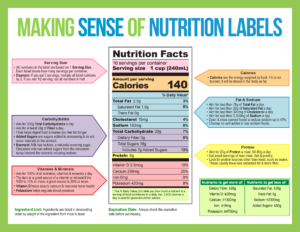
Making Sense of Nutrition Labels
Making sense of the Nutrition Facts label on food packaging can help make healthy choices easier! Check out the useful information nutrition labels can provide and how to use them to compare food.
Why read nutrition labels?
- Know whats in your food
- Easily compare items
- Know serving size and calories per serving
- Lists percent daily value (%DV) or recommended amount of nutrients you need in a day
- Lists ingredients of things you want more of like whole grains and things you want less of like saturated fat, trans-fat, added sugar and sodium
- Identify food allergens (if appropriate for you or your family)
- Accuracy of the label is Food and Drug Administration (FDA) approved
Breaking down the label
- Serving size:
Labels show the nutrition facts for one suggested serving so you should multiply all the values on the label by the number of servings you eat. For example, if you eat two servings, multiply all the values by two. If you eat half of a serving, divide all numbers in half to determine the number of each nutrient. This part of the nutrition label also gives you the total number of servings in the package.
- Calories:
Calories are the amount of energy provided by one serving of a food item. To help maintain healthy body weight, the number of calories you consume from food and beverages should equal the number of calories your body uses. A 2,000 calorie diet is used as a general guide but each person’s calorie needs may be higher or lower depending on your age, height, weight, and activity level. To learn more about your estimated energy needs and daily recommended amounts of each food group, visit https://www.choosemyplate.gov/resources/MyPlatePlan. Remember, the number of calories you get from a food item depends on the number of servings you eat.
- Fat:
About 30% of our daily calories should come from fat. For a 2,000 calorie diet, that would be about 66 grams of total fat per day. Choose foods that are low in saturated fat. Aim for less than 20 grams of saturated fat a day. Not all fats are bad! Replacing foods that are high in saturated with foods higher in unsaturated fats like fish and nuts can help improve cholesterol and lipid levels.
- Cholesterol:
This nutrient is typically found in animal food products like meat, eggs, and dairy. Aim for less than 300 mg of cholesterol a day.
- Sodium:
Aim for less than 2,300 mg of sodium a day. We can reduce the amount of sodium in our diets by reducing the amount of salt we use in cooking, but sodium also comes from other ingredients in packaged foods. To reduce the amount of sodium in your diet, rinse, and drain canned products like beans to cut up to 41% of sodium. Also, choose no-salt-added or low-sodium options whenever possible.
- Carbohydrates:
We should get the majority of our energy from carbohydrates. Aim for 45-65% of calories per day from carbohydrates or about 225-325 grams of total carbohydrates a day (for a 2,000 calorie diet). There are three types of carbohydrates: starches, fiber, and sugar. Fiber helps to digest food, helps you feel satisfied longer, and can help lower cholesterol levels. Women ages 18-50 years should aim for 25 grams of fiber a day. Men ages 18-50 years should aim for 30-38 grams of fiber a day.
Some foods naturally contain sugars like fruit, dairy and grains. Sweetening foods with sugar, syrups or honey counts as added sugar. Aim to eat less than 10% of total calories from added sugar. For example, milk has lactose, a naturally-occurring sugar. Chocolate milk has added sugars from the chocolate syrup beyond the naturally-occurring lactose.
- Protein:
For a 2,000 calorie diet, aim for 20-25 grams of protein at a meal and 50-60 grams total a day. To get the right amount of protein, eat small servings of lean meat, fish, and poultry. Eat a variety of protein to maximize health benefits. Include meatless protein options like nuts, seeds, eggs, beans, and soy because these usually have less fat and more fiber.
- Vitamins and minerals:
Aim to get 100% in all nutrients, vitamins, and minerals throughout the day. Food items are considered a good source of a vitamin or mineral if %DV is 10% or greater; a great source is 20%! The vitamins and minerals that are listed on the nutrition label are
- Vitamin D: important for strong bones
- Calcium: important for strong bones
- Iron: important for blood health, helps prevent anemia
- Potassium: important for blood pressure and cardiovascular health
| nutrients to get more of | nutrients to get less of |
| fiber: ≥28g | saturated fat: ≤20g |
| vitamin D: ≥20mcg | trans fat: 0g |
| calcium: ≥1300mg | sodium: ≤2300mg |
| iron: ≥18mg | added sugars: ≤50g |
| potassium: ≥4700mg |
- Ingredient list:
Items on the ingredient list are written in order of weight from most to least. Foods you want to get more of should be higher on the list. For example, when choosing grains like cereal, look for whole grains to be the first item on the ingredients list.
- Expiration date:
Check the expiration date! There are many versions of expiration dates. The “sell-by” date tells the store how long they can display the item for sale. A date that says “best if used before” or “use-by” tells you when the food product is at the best quality. Avoid buying products that are past any of these dates.




Is this available in a poster size? If so, is there anyway I could get one?
No, unfortunately, we do not have this information available as a poster.